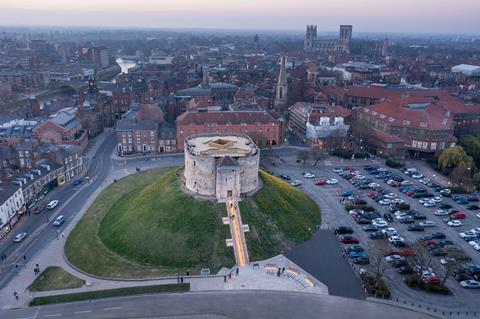Scheme in York not awarded top prize in RIBA regional award because of concerns over disability access
Hugh Broughton Architects has said its restoration of Clifford’s Tower in York could not incorporate wheelchair accessibility without having a “catastrophic impact” on the 11th century monument after the project was not awarded RIBA’s top architecture prize for the region.
The scheme had been unanimously chosen as the winner of RIBA Yorkshire’s 2024 Building of the Year award but was pulled at the last minute because the lack of wheelchair access at the site was deemed to be in conflict with RIBA’s core values.
Practice founder Hugh Broughton has now said the nature of the site, which sits atop a steep 10m high mound, made fulfilling client English Heritage’s brief for the project to include significant accessibility improvements “extremely challenging”.

He said the practice and the project’s access consultant, Martin McConaghy of IDACS, had worked with several access groups in York and prepared nine options to improve accessibility. Government heritage advisor Historic England was then consulted on the impact these options would have on the scheduled ancient monument.
Proposed interventions included a spiral ramp, a funicular, a lift tower and a lift buried within the mound itself, all of which would have severely damaged the site, Broughton said, adding that this had been “both recognised and highlighted by the access groups we consulted with”.
The longlist was then narrowed down to four options which were sent to a public vote conducted both online and in person to ask for a preferred solution.
> Also read: RIBA Yorkshire Building of the Year winner deemed “not appropriate” due to lack of wheelchair access
Broughton said the solution selected in the public consultation was the design which was built, which includes handrails and resting areas in the steps leading up to the castle and a ”myriad of features to enhance physical and intellectual access” inside the tower, including braille panels.
He added: “We realise that the RIBA National Panel are probably unaware of this process. However, we hope that this explanation will provide them with reassurance that we and English Heritage place access to this country’s heritage as a primary priority, just as they do, and that we have achieved a remarkably accessible solution in the context of significant challenges.”
Jury chair for the RIBA Yorkshire awards Lucy Plumridge said that the central RIBA awards group felt that it “would not be appropriate” for the project to receive the award because of the lack of wheelchair access.
The restoration of Clifford’s Tower, which includes a new timber roof and walkways, was praised by RIBA judges for its “quality and the craftsmanship” and for “transforming and preserved the [original] building for future generations.” The scheme, which was designed in collaboration with heritage conservation practice Martin Ashley Architects, was handed the region’s Conservation Award and Client of the Year.
Hugh Broughton’s Architect’s statement in full:
“We are thrilled that our designs for Clifford’s Tower have been recognised by RIBA Yorkshire with a Regional Award and the Conservation Award. We are also so pleased for our amazing client, English Heritage, that they have been recognised as Client of the Year. The recent news that the project was also considered by the regional panel as their Building of the Year is also exciting, although disappointing that it was not presented.”
”English Heritage’s brief for the project included making significant improvements to access, which is extremely challenging in the context of a Scheduled Ancient Monument sitting atop a 10-metre mound and which is seen in the round. However, with the help of our access consultant, Martin McConaghy of IDACS, we consulted with multiple access groups in the City of York, prepared nine options to enhance physical access and then assessed these using a Multi Criteria Assessment. This process included working with Historic England to assess the potential harm of each option to the heritage asset. Options included a spiral ramp, an independent lift tower, a funicular and even a lift buried in the motte, all of which would have had catastrophic impact on the monument, which was both recognised and highlighted by the access groups we consulted with.”
”This longlist was narrowed down to 4 options which were then presented to the public to ask for their preferred solution in a vote conducted in person and online. The solution they selected is the design which has been built. It provides seating and interpretation in a new public space created at the foot of the motte. It retains the steps up to the tower, constructed in the 1930s and famously portrayed in LS Lowry’s painting of the tower (1952) but introduces new handrails and resting points. Within the tower we also introduced a myriad of features to enhance physical and intellectual access including braille interpretation, hearing loops, new stairs and handrails, and soundscapes. All the measures were developed with the help of IDACS and in consultation with access groups within York.”
”We realise that the RIBA National Panel are probably unaware of this process . However, we hope that this explanation will provide them with reassurance that we and English Heritage place access to this country’s heritage as a primary priority, just as they do, and that we have achieved a remarkably accessible solution in the context of significant challenges.”



























No comments yet